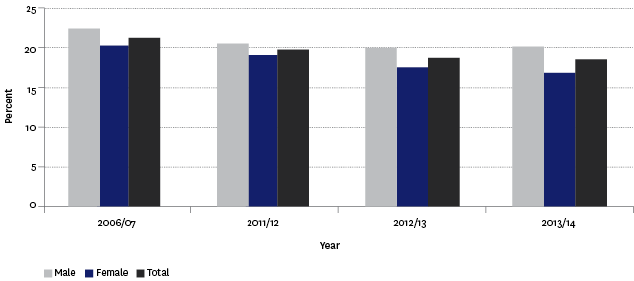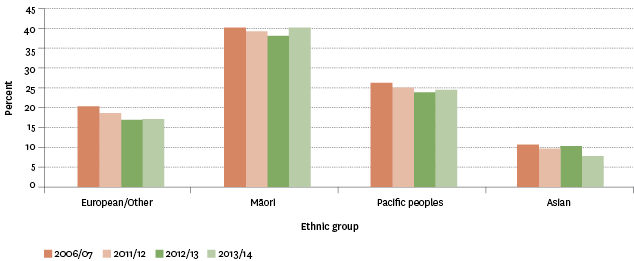Health
Cigarette smoking
Definition
The proportion of the population aged 15 years and over who currently smoked cigarettes.
RelevanceTop
Exposure to environmental tobacco smoke (particularly maternal smoking) is a major risk factor for Sudden Infant Death Syndrome and respiratory problems in children.
Current level and trendsTop
In 2013/2014, the age-standardised proportion of current smokers was 18.5 percent, as measured in the New Zealand Health Survey. This was similar to 2012/2013 (18.7 percent) but lower than 2011/2012 (19.8 percent) and significantly lower than 2006/2007 (21.3 percent). Between 2006/2007 and 2013/2014, the proportion of the population who were current smokers decreased 2.8 percentage points.
In 2013/2014, an estimated 615,000 New Zealanders aged 15 years and over were current smokers (ie had smoked more than 100 cigarettes in their lifetime and currently smoked at least once a month), a decrease of 11,000 from 2012/2013.
The age-standardised rate of daily smokers (ie had smoked more than 100 cigarettes in their lifetime and currently smoked at least once a day) was similar to the current smokers’ rate (16.5 percent of the population).
Age and sex differencesTop
In 2013/2014, males were more likely than females to be current smokers (20.2 percent of males compared with 16.9 percent of females).
Between 2006/2007 and 2011/2012, the proportion of male current smokers dropped from 22.4 percent to 20.6 percent and has stayed at approximately 20 percent for 2012/2013 and 2013/2014. In comparison, the proportion of female current smokers has shown a gradual decrease from 20.3 percent in 2006/2007 to 16.9 percent in 2013/2014.
Figure H7.1 – Proportion of population aged 15 years and over who were current smokers,
by sex, 2006/2007–2013/2014

Source: Ministry of Health, New Zealand Health Survey
Note: Data has been age-standardised to the WHO World Standard population.
In 2013/2014, those aged 25–34 years were most likely to be current smokers (25.7 percent), followed by those aged 45–54 years (20.9 percent). In contrast, only 8.2 per cent of those aged 65–74 years and 4.1 percent of those aged 75 years and over were current smokers. This pattern was similar for each of the four surveys’ time periods.
Table H7.1 – Proportion of population aged 15 years and over who were current
smokers, by age group and sex, 2006/2007–2013/2014
| 15–24 | 25–34 | 35–44 | 45–54 | 55–64 | 65–74 | 75+ | |
|---|---|---|---|---|---|---|---|
| 2006/07 | |||||||
| Male | 23.4 | 30.9 | 24.1 | 23.1 | 14.3 | 11.2 | 5.4 |
| Female | 23.5 | 25.9 | 20.7 | 19.8 | 15.7 | 10.5 | 3.4 |
| Total | 23.5 | 28.3 | 22.3 | 21.4 | 15.0 | 10.9 | 4.0 |
| 2011/12 | |||||||
| Male | 20.0 | 30.7 | 21.3 | 18.1 | 17.5 | 10.7 | 4.5 |
| Female | 23.0 | 24.8 | 22.1 | 15.5 | 12.5 | 7.9 | 4.5 |
| Total | 21.5 | 27.7 | 21.8 | 16.8 | 14.9 | 9.3 | 4.5 |
| 2012/13 | |||||||
| Male | 19.1 | 27.4 | 23.9 | 19.2 | 15.2 | 8.4 | 4.9 |
| Female | 18.8 | 21.5 | 17.6 | 20.7 | 14.4 | 7.6 | 4.3 |
| Total | 19.0 | 24.4 | 20.6 | 19.9 | 14.8 | 8.0 | 4.5 |
| 2013/14 | |||||||
| Male | 21.6 | 28.1 | 19.3 | 22.2 | 14.5 | 9.0 | 4.4 |
| Female | 15.7 | 23.5 | 17.7 | 19.6 | 12.7 | 7.4 | 3.7 |
| Total | 18.7 | 25.7 | 18.4 | 20.9 | 13.6 | 8.2 | 4.1 |
Source: Ministry of Health, New Zealand Health Survey
Note: Data has been age-standardised to the WHO World Standard population.
Ethnic differencesTop
There were large differences in the prevalence of smoking for different ethnic groups. In 2013/2014, 40.2 percent of Māori adults were current smokers, compared with 24.4 percent of Pacific peoples, 17.1 percent of people in the European/Other group and 7.7 percent of people in the Asian ethnic group.
This pattern of differences between ethnic groups is also present in previous years. The proportion of current smokers who were of European/Other ethnicity was gradually decreasing over time.
Figure H7.2 – Proportion of population aged 15 years and over who were current smokers,
by ethnic group, 2006/2007–2013/2014

Source: Ministry of Health, New Zealand Health Survey
Note: Data has been age-standardised to the WHO World Standard population.
Socio-economic differencesTop
In 2013/2014, a greater proportion of people living in the most deprived areas were current smokers, compared with people living in the least deprived areas (ie 32.6 percent for those in NZDep2013 quintile level 5, compared with 8.0 percent for those living in NZDep2013 quintile level 1 and 13.2 percent living in NZDep2013 quintile level 2).
The proportion for NZDep2013 quintile levels 3 and 4 were 17.8 percent and 21.6 percent respectively.
Regional differencesTop
In 2013/2014, people living in Gisborne (30.0 percent) and Northland (29.1 percent) had the highest proportion of current smokers. Those living in Auckland (15.0 percent) and Canterbury (17.0 percent) had the lowest proportion of current smokers.
International comparisonTop
Daily smoking rates are used for international comparisons. In an OECD comparison of daily smoking rates of adults in 2011 or the nearest available year, New Zealand (16.5 percent) had a lower rate than the OECD median rate of 20.3 percent. The United States (14.8 percent), Australia (15.1 percent) and Canada (15.7 percent) had lower rates of daily smoking than New Zealand, while most of the European and Asian countries had higher rates (eg the United Kingdom had a rate of 19.6 percent and Ireland 29.0 percent).
Data for this section can be found at: www.socialreport.msd.govt.nz/documents/2016/h7.xlsx

